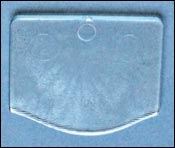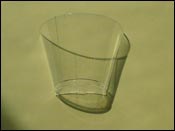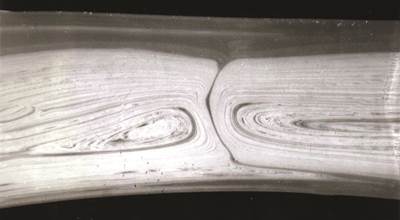Find the Source of Visual Defects
The appearance of visual defects on parts such as cracking, crazing, grooves, ripples, wave marks, and flaky brittleness often indicates more than an aesthetic problem.
The appearance of visual defects on parts such as cracking, crazing, grooves, ripples, wave marks, and flaky brittleness often indicates more than an aesthetic problem. Many of these common visual defects are an indication of part failure resulting from internal and external stresses exceeding the strength of the part. The most common causes of these stress-induced visual defects derive from issues ranging from the environment to the process, polymer, and sometimes the mold or part design. Taking a closer look at what defect appears on the part provides direction on what to do about it.
These are some of the more common visual defects:
- “Record grooves” (or ripples or wave marks) are concentric grooves or lines, usually at the leading edge of flow. They occur when the flow front hesitates, building up pressure, then moves a short distance and hesitates again. It is almost always related to a lack of adequate pressure at the flow front or slowing of the injection velocity.
- Brittleness can be caused by over- or under-packing, or contamination or degradation of the polymer, or contact with an environmental stress-cracking agents
- Cracking can occur either locally or throughout the part.
- Crazing is a whitening caused by fine lines or small cracks, usually confined to a small area.
CHECK PROCESS & POLYMER
Appearance of grooves in a part typically boils down to one of three process issues. The trouble may stem from a pressure or volume problem or from a position or switchover (transfer) issue. In rare cases, it may be a question of temperature.
Limited first-stage filling pressure or a lack of velocity control can be the source of the problem. Double check the peak hydraulic pressure during the first stage—it should be 200 to 400 psi lower than the first-stage set limit. Packing pressure or rate or the melt volume during second-stage pack and hold also may be low, so try increasing the pack pressure and rate, if possible.
Incorrect transfer position from the first to second injection stage can cause visual defects. Take the second-stage pressure off by reducing the pack or hold pressure to 300 psi plastic pressure, or if the machine does not allow this, cut the second-stage time to zero. The result should be a part that is 95% to 99% full. A thin-walled part will fill with only slight under-pack near the gate. Adjust the transfer position to provide appropriate fill volume (95% to 99% full).
Poor first-to-second-stage switchover response may also be a cause of visual defects. To remedy this, note the response of the hydraulic-pressure switchover. It should rise to the transfer point then drop rapidly to the set second-stage pressure. If the pressure drops much below the second-stage setpoint, the flow front may be hesitating and building a high viscosity. If you see this you may need to repair the machine!
Low melt or mold temperatures are other sources of difficulty. Check the melt temperature via a hot-probe technique or appropriate infrared sensor. Make sure the melt temperature is within the supplier’s recommended range. If mold temperature is the culprit, increase it 20° to 30° F or shorten cycle time. This will raise the steel temperature.
For cracking, crazing, or brittleness, look for process-related causes of stress in the part, such as injection too fast or too slow. Fast injection can lead to high molecular orientation, especially in thin-wall parts. Consider the gate location to provide proper molecular orientation and weld-line positioning. Try injecting the part at both fast and slow injection speeds to see the effect of orientation.
If the part is cracked or crazed right out of the mold, check the part before ejection and then drastically slow down ejection and note if that is when problem occurs. If ejection is the cause, look for undercuts in the mold, improper polish in the direction of ejection (draw), too high an ejection velocity, or not enough ejection area.
Either over-packing or under-packing the gate can cause brittleness in the part. This is because both phenomena can produce parts with high internal stress, especially near the gate. Over-packing at or near the gate causes the polymer chains to be packed too closely together. At room temperature, the polymer chains in an over-packed part may still be free to move a little. But at low temperatures, shrinkage may leave the chains too tightly packed or compressed, so a crack develops. Tightly packed chains lead to retained compressive stress, causing brittleness and part failure. Under-packing at/near the gate causes the polymer molecules to be too far apart during cooling, leading to tensile stresses that also weaken the part around the gate.
To check for under or over-packing, run a gate-seal analysis to find how long it takes to freeze or seal the gate. Test-run the parts with the gate sealed and unsealed, noting if there is a difference in performance (defined according to the parts’ application). Be sure to thermally cycle the parts from -40 to +240 F and check both high- and low-temperature performance. For example if you were testing a 5-gal bucket, tests of impact, sealing, and stack load should be done at around -40 to +240 F (-40 to +115 C), the latter approximating a dark roof on a tractor trailer in Arizona on a hot summer day.
Thermal cycling is important to check for possible warpage as the part goes from hot to cold and back to hot again. Molecules under stress will try to relieve that stress. Thermal cycling will tell you if the molecules are stressed or relaxed. Better to find out before the customer has to deal with failed parts.
DESIGN FLAWS
A crack occurring at a weld line may signal an improper gate location. As noted in our last Injection Molding Troubleshooter (see Learn More), it is important to choose a gate location that places the weld line in a “least-stressed” area. Also, if possible, place the gate so that there is some distance of flow after the flow fronts meet to allow good melding and a stronger weld line.
Localized defects can also be related to mold or part design such as a sharp corner with little or no radius. Sharp corners concentrate stresses and act as a “notch” where the failure can start and then propagate. A radius at a corner spreads the load across a larger area. Some resins are more notch sensitive than others, for example polycarbonate is more sensitive than ABS, and hence you see many applications for PC/ABS blends.
DEGRADATION PROBLEMS
Cracking or brittleness, when found throughout the entire part, originates in the conditions to which the polymer has been exposed in processing. One of the biggest causes is molecular-weight degradation, due to either excessive processing temperatures or to hydrolysis. Both break the long polymer chains into shorter chains that have lower properties but flow easier.
Processors using Scientific Molding principles and velocity control should check the melt pressure at transfer from the first- to second-stage injection and see if it is lower than normal. That is a signal that the melt viscosity is too low, and degradation may be the cause.
To see if you are dealing with temperature-driven degradation, check the melt temperature with a hot probe or IR sensor, and make adjustments if necessary. Check all barrel heats and duty cycles. Is the controller’s PID loop working properly? See whether the heater calls for power periodically or is constantly on or off. Proper PID function will only periodically call for power.
Also check the residence time of the material in the barrel. High temperature for long residence times degrades resins. Residence times get longer as the screw and barrel get worn. Check their condition, as well as that of the check ring or non-return valve—is it cracked or chipped?
To see if hydrolysis is causing molecular-weight degradation, find out whether your polymer is of a type that can undergo hydrolysis, where minute amounts of water react with the polymer in the barrel of the machine. The water can act as a pair of scissors the cut the long polymer chain into shorter segments. (Polyesters, polycarbonates, acetals, nylons, and TPUs are susceptible to such hydrolysis, but styrenics, polyolefins, and acrylics generally are not.) You may need to check whether your dryers are operating properly or whether dried resin is being allowed to re-absorb moisture before it is molded.
REGRIND & COLORANT
Cracking or brittleness can also occur if regrind material is too degraded or is contaminated. Check the amount and quality of regrind being run. Compare parts molded with 100% virgin material.
To find contamination, check localized areas for off-color or foreign material, and check the regrind for any trace contaminants. Confirm that the regrind does not contain mixed materials or is not a match for the virgin material.
Also confirm the melt flow rate (MFR) of the polymer being used—both the pellets and the parts—and contact the supplier if the pellets’ MFR is not what it should be. If the MFR of the pellets is within specification, but the MFR of the parts is not within 30% of that of the pellets, then you may have a processing problem that is causing degradation. At least, that may be the case for neat resins. For resins containing fillers such as glass fiber, the normal range of difference in MFR before and after processing can go much higher, because processing breaks the glass fibers.
Cracking can also occur if the wrong type or amount of colorant is used, so check the masterbatch letdown ratio and type of colorant carrier. Localized cracking or crazing also can occur from solvents, surfactants, or chemicals. Inspect your procedures for mold and part handling and cleaning. Look for possible contact with environmental stress agents such as soaps, oils, or
surfactants.
ABOUT THE AUTHOR
John W. Bozzelli has taught seminars on plastics design and processing for more than 30 years. He has extensive experience in polymer development and processing from more than 20 years with Dow Plastics. He is the founder of Injection Molding Solutions/Scientific Molding in Midland, Mich., a provider of in-plant training and consulting services. Tel: (998) 832-2424 or e-mail: John@scientificmolding.com
Related Content
Back to Basics on Mold Venting (Part 2: Shape, Dimensions, Details)
Here’s how to get the most out of your stationary mold vents.
Read MoreFundamentals of Polyethylene – Part 6: PE Performance
Don’t assume you know everything there is to know about PE because it’s been around so long. Here is yet another example of how the performance of PE is influenced by molecular weight and density.
Read MoreThree Key Decisions for an Optimal Ejection System
When determining the best ejection option for a tool, molders must consider the ejector’s surface area, location and style.
Read MoreBack to Basics on Mold Venting (Part 1)
Here’s what you need to know to improve the quality of your parts and to protect your molds.
Read MoreRead Next
What to Do About Weak Weld Lines
Weld or knit lines are perhaps the most common and difficult injection molding defect to eliminate.
Read MoreSee Recyclers Close the Loop on Trade Show Production Scrap at NPE2024
A collaboration between show organizer PLASTICS, recycler CPR and size reduction experts WEIMA and Conair recovered and recycled all production scrap at NPE2024.
Read MoreFor PLASTICS' CEO Seaholm, NPE to Shine Light on Sustainability Successes
With advocacy, communication and sustainability as three main pillars, Seaholm leads a trade association to NPE that ‘is more active today than we have ever been.’
Read More
.jpg;width=70;height=70;mode=crop)























